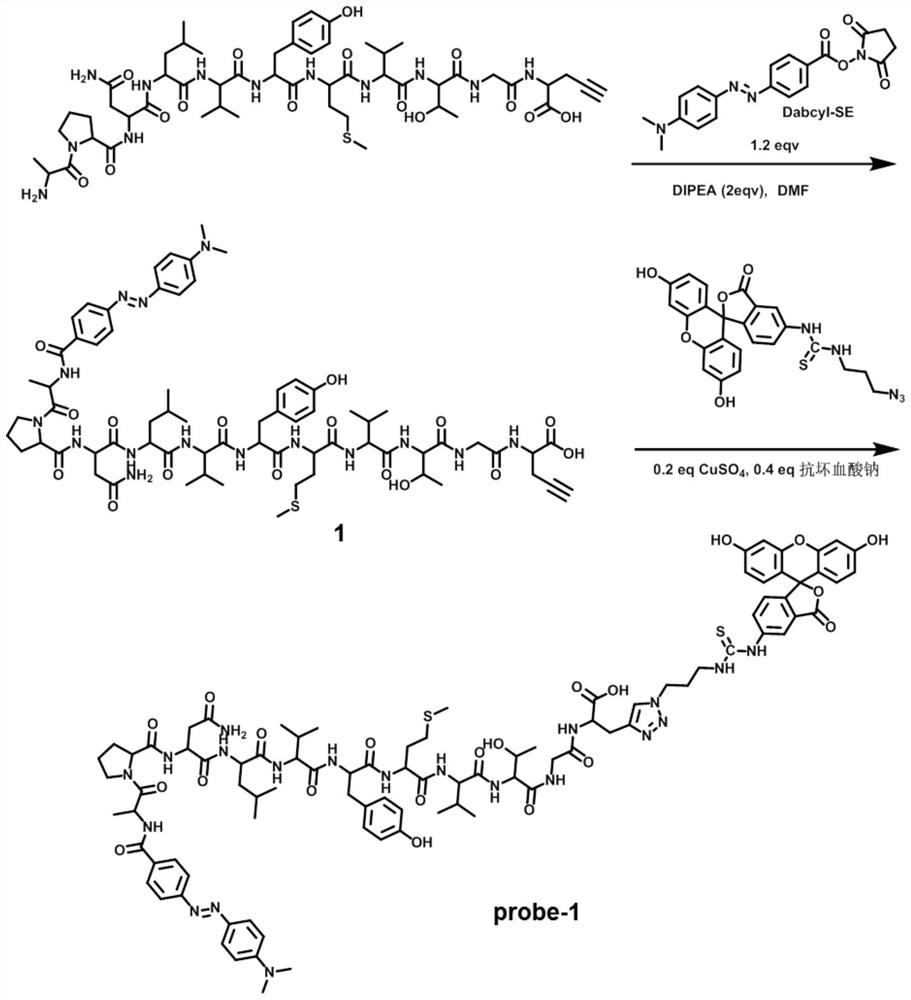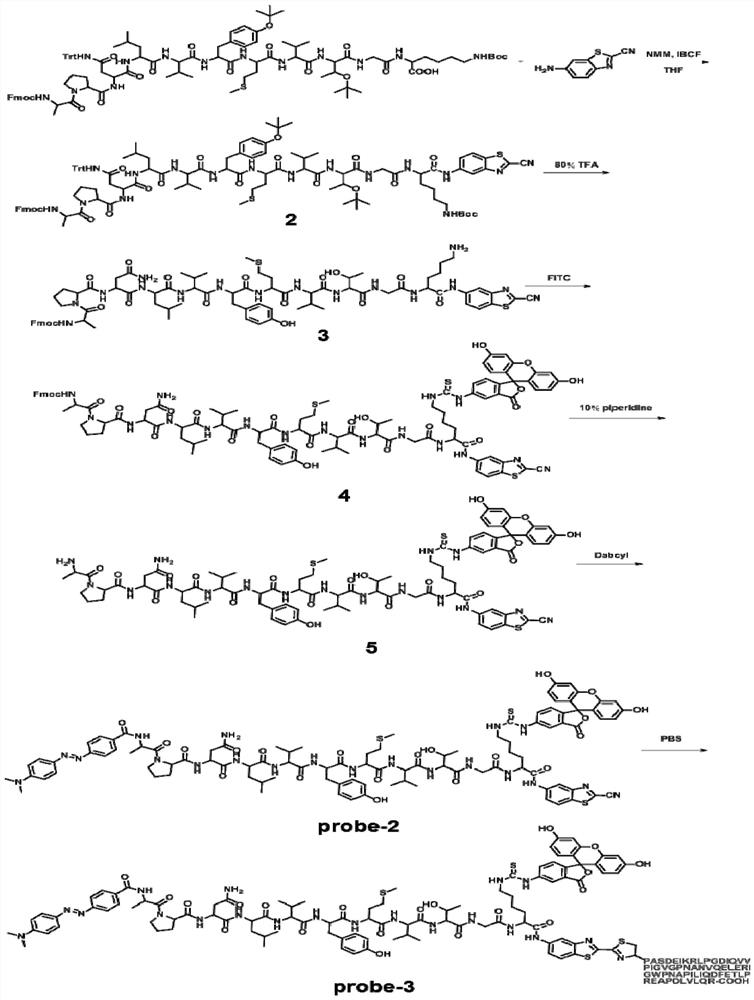A diagnostic probe for thrombotic thrombocytopenic purpura and its preparation method and application
A technology for platelet and purpura disease, applied in the field of biological analysis, can solve the problems of high technical requirements, expensive kits, complicated operation, etc., and achieve the effect of good biocompatibility, mild conditions and high resolution
- Summary
- Abstract
- Description
- Claims
- Application Information
AI Technical Summary
Problems solved by technology
Method used
Image
Examples
Embodiment 1
[0059] Example 1: Synthesis and characterization of the molecular probe probe-3 for the diagnosis of thrombotic thrombocytopenic purpura and the comparison probes probe-1 and probe-2
[0060] (1) Add compound 8 (10 mg, 0.0086 mmol, structural formula below) into a 10 mL round bottom flask, dissolve it with 4 mL of N,N-dimethylformamide, and then add DABCYL (3.8 mg, 0.01 mmol) and diisopropylethylamine (1.5 mg, 0.017 mmol), stirred at room temperature for 2 h. After the reaction, it was separated and purified by HPLC to obtain intermediate 1 (its structure is as follows) (9.7 mg, yield: 80%). MS (MALDI-TOF) Calc'd for C 68 h 95 N 15 o 16 S Na[M+Na] + , 1432.680,; found, 1432.454.
[0061]
[0062]
[0063] Add Intermediate 1 (9 mg, 0.0064 mmol) and 5-fluorescein isothiocyanate (FITC-N 3 ) (3.75 mg, 0.010 mmol), and dissolved in DMSO (1 mL), stirred well. At the same time, sodium ascorbate (0.5 mg, 0.0026 mmol) and anhydrous copper sulfate (0.2 mg, 0.0013 mmol) wer...
Embodiment 2
[0072] The DMSO mother solution of the thrombotic thrombocytopenic purpura diagnostic molecular probe probe-3 prepared in Example 1 was dissolved in a conventional buffer solution (5 mmol / L Bis-Tris, 25 mmol / L CaCl 2 , 0.005% Tween20, pH 6.0), and then add normal human plasma, 37 o C. Incubate for 2 h under shaking at 500rpm, and then use a fluorescence spectrometer to detect the change of the fluorescence signal of the solution: when no plasma is added, the solution containing probe-3 cannot detect fluorescence, after adding plasma for incubation, the energy between FITC and DABCYL The resonance shift becomes weaker and the fluorescence recovers, indicating that probe-3 can be used as a detection probe for von Willebrand factor cleavage protease (ADAMTS13).
Embodiment 3
[0073] Example 3 HPLC purity characterization and high-resolution mass spectrometry characterization of molecular probes probe-1, probe-2, and probe-3
[0074] After diluting the diagnostic molecular probes probe-1, probe-2 and probe-3 for thrombotic thrombocytopenic purpura prepared in Example 1 with solvent methanol to a concentration of 5 μM, the molecular weight of the probes was determined by high-resolution mass spectrometry identified and analyzed for purity using high performance liquid chromatography.
[0075] Such as image 3 As shown in a, using Agilent 1260 high performance liquid chromatography to analyze the sample, the retention time of probe-1, the diagnostic molecular probe for thrombotic thrombocytopenic purpura, was 8.163 minutes, and the peak area was further integrated to calculate the The probe concentration was as high as 98%. image 3 b shows the theoretical m / z of probe-1, a molecular probe for the diagnosis of thrombotic thrombocytopenic purpura: 19...
PUM
 Login to View More
Login to View More Abstract
Description
Claims
Application Information
 Login to View More
Login to View More - R&D
- Intellectual Property
- Life Sciences
- Materials
- Tech Scout
- Unparalleled Data Quality
- Higher Quality Content
- 60% Fewer Hallucinations
Browse by: Latest US Patents, China's latest patents, Technical Efficacy Thesaurus, Application Domain, Technology Topic, Popular Technical Reports.
© 2025 PatSnap. All rights reserved.Legal|Privacy policy|Modern Slavery Act Transparency Statement|Sitemap|About US| Contact US: help@patsnap.com



